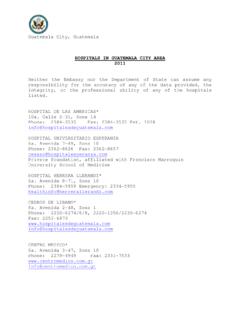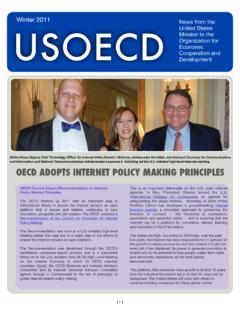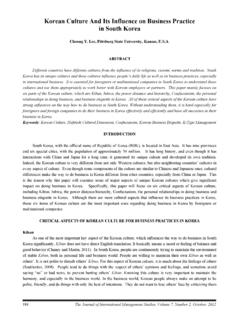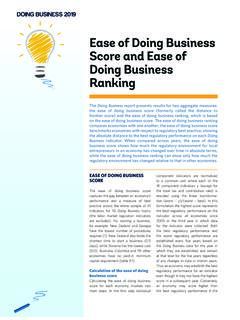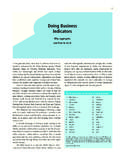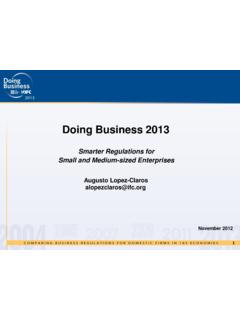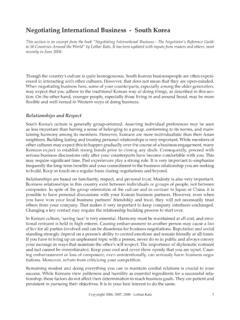Transcription of Doing Business in Latvia: 2014 Country Commercial Guide ...
1 Doing Business in latvia : 2014 Country Commercial Guide for Companies INTERNATIONAL COPYRIGHT, & FOREIGN Commercial SERVICE AND DEPARTMENT OF STATE, 2010. ALL RIGHTS RESERVED OUTSIDE OF THE UNITED STATES. Chapter 1: Doing Business In latvia Chapter 2: Political and Economic Environment Chapter 3: Selling Products and Services Chapter 4: Leading Sectors for Export and Investment Chapter 5: Trade Regulations, Customs and Standards Chapter 6: Investment Climate Chapter 7: Trade and Project Financing Chapter 8: Business Travel Chapter 9: Contacts, Market Research and Trade Events Chapter 10: Guide to Our Services Return to table of contents Chapter 1: Doing Business in latvia Market Overview Market Challenges Market Opportunities Market Entry Strategy Web Resources Market Overview Return to top The United States and the European Union (EU), with its 28 member states, including latvia , enjoy a mature economic relationship that is characterized by nearly $4 trillion in two-way investment as well as a massive merchandise trade of $787 billion in 2013 - double the level from exports of goods and services to the EU-28 in 2013 reached approximately $262 billion and imports from the EU, $387 It is estimated that transatlantic commerce generates more than 15 million jobs.
2 Recognizing that the economic relationship is already the world s largest, accounting for one-third of total trade in goods and services and nearly half of global economic output, President Obama, in his State of the Union address on February 12, 2013, announced the Administration s plans to begin negotiations on a Transatlantic Trade and Investment Partnership (T-TIP) with the EU. The negotiations were officially launched at the G8 Summit on June 17, 2013. T-TIP is an ambitious and comprehensive trade and investment agreement that will promote transatlantic international competitiveness, jobs and growth. T-TIP aims to address non-tariff barriers that impede trade in goods and services and seeks to promote greater compatibility, transparency and cooperation in the regulatory and standards arenas.
3 According to Government estimates, transatlantic zero-tariffs could boost and EU exports each by 17%.3 A 25% reduction in non-tariff barriers could increase the combined EU and GDP by $106 For up-to-date information on T-TIP, please visit the website of the USTR. According to forecasts by the European Commission (EC), full-year real GDP growth for 2014 is projected to rise for both the eurozone5 ( ) and for the EU as a whole ( ). EC forecasts suggest stronger growth for 2015 at for the Eurozone and for the overall EU. The EC anticipates a return of confidence and a strengthening global 1 The Transatlantic Economy 2014, Annual Survey of Jobs, Trade and Investment between the and Europe; Daniel Hamilton and Joseph Quinlan 2 US Dept of Commerce, Office of the EU 3 The Transatlantic Economy 2014, Annual Survey of Jobs, Trade and Investment between the and Europe; Daniel Hamilton and Joseph Quinlan 4 ibid 5 The eurozone is an economic and monetary union (EMU) of 18 EU member states that have adopted the euro as their common currency and sole legal tender.
4 The eurozone consists of Austria, Belgium, Cyprus, Estonia, Finland, France, Germany, Greece, Ireland, Italy, latvia , Luxembourg, Malta, the Netherlands, Portugal, Slovakia, Slovenia, and Spain. Lithuania will adopt the Euro on January 1st, 2015, becoming the 19th eurozone member state. economy over 2014, both of which should continue to help Europe rebound. According to the EC6: - The EU Country with the strongest growth in 2014 will be latvia ( ); the weakest growth will be Cyprus ( ); - Two Eurozone countries, Cyprus ( ) and Slovenia (-1%) will be in recession in 2014; - unemployment is forecast for 2015 in the Eurozone and in the entire EU. Unemployment figures are expected to run from in Austria to in Spain in 2014.
5 Youth unemployment is substantially higher in countries with negative growth. latvia is a small nation with a stable political environment and a dynamic economy that is at present one of the fastest growing countries in the EU. latvia is similar in size to North Carolina, with a population of approximately million. The Country provides an attractive market for American IT equipment and services, capital machinery and equipment, medical and consumer products, and energy products. Located at the center of the three Baltic States, latvia is a member of the European Union (EU) and provides a strategic location as a Commercial , financial, and transportation hub for the Nordic/Baltic region and areas to the east.
6 After suffering the worst economic decline in Europe between 2008 and 2010, the Latvian government enacted successful fiscal reforms, and latvia s economy grew by percent in 2012 and percent in 2013. latvia became a member of the Eurozone on January 1, 2014. The Commercial environment is generally friendly to foreign companies, and EU directives are implemented and observed. There are no controls on import, export, or the use and conversion of foreign currencies, which facilitates investment and the repatriation of profits. The Latvian government has adopted modern laws establishing copyrights, patents and trademarks and the means for enforcing their protection. Telecommunication services are modern, and the real estate market provides both modern residential and Business space.
7 English is widely spoken in government and Business . Many companies Doing Business in latvia rate the Business environment among the best in Central and Eastern Europe. On May 30, 2014, the credit rating agency Standard & Poor s gave latvia the fourth highest investment grade A- indicating its economic strength and improving national wealth. The legal system, tax structures, and trade and other regulations have been significantly modified to harmonize with EU standards. Most EU directives have been incorporated into the Latvian legislative system. latvia has been a member of the WTO since 1999. The Country joined the EU and NATO in 2004 and latvia began the process to accede to the Organization for Economic Cooperation and Development (OECD) in May 2013.
8 Market Challenges Return to top 6 Due to the Country 's small size, if a company is considering Doing Business only in latvia , local labeling requirements could prove costly relative to the potential customer base. Many companies focus on latvia as part of the broader Baltic region or EU market. Because the market is small, it can be quickly saturated, and it can be difficult to keep Business secrets. American products face strong competition in the Latvian market from EU countries and the Commonwealth of Independent States (CIS). Due to historical trade relations, companies from Scandinavian countries and Germany approach the Latvian market with greater confidence.
9 Entrenched government bureaucracy and moderately high levels of corruption are impediments to the growth of trade and investment in latvia . Some concerns exist regarding the protection of intellectual property, but recent legislative changes promise to give law enforcement additional tools to address these issues. Market Opportunities Return to top The Latvian economy is based on service industries including transportation, information technology, and financial services. The construction industry also plays an important role, as do wood and forestry products, food processing, metalworking, and light industries ( , textiles). Tourism is growing rapidly. latvia has a flat corporate income tax rate of 15%.
10 The Country is well connected by approximately 80 direct flights to all major European cities, a weekly direct flight to New York, and plenty of connecting flights. latvia s state-owned national air carrier, airBaltic, has made Riga a regional hub. In 2014-2020, the Latvian government will administer approximately $ billion of EU structural funds. The Latvian government provides several incentives for investment including tax incentives, labor related incentives, incentives for research and development, and state credit guarantees. Please see the website of the Latvian Investment and Development Agency for detailed information on the available incentives and tax allowances: The European Bank for Reconstruction and Development (EBRD) operates in latvia out of its regional office in Vilnius, Lithuania.





